Abstract
The relative contributions of catalase and the selenoenzyme glutathione peroxidase (GSH-Px) were elucidated in the rat liver by selectively modulating the activities of these enzymes using dietary selenium (Se) and the catalase inhibitor 3-amino-1,2,4-triazole (3-AT). Increased peroxidation occurred only in Se-deficient rats with markedly reduced cytosolic and mitochondrial GSH-Px activities. Although 3-AT treatment resulted in a 75% reduction of hepatic catalase activity and also a 20% reduction of both cytosolic and mitochondrial superoxide dismutase (SOD) activity, no incremental increase in peroxidation was observed over that associated with Se deficiency. In Se-deficient animals, treatment with 3-AT resulted in a doubling of cytosolic GSH-Px. This was associated with a 49% elevation in hepatic Se suggesting that increased Se may have contributed to the enhanced GSH-Px activity. These results suggest that GSH-Px plays the pivotal role in preventing hepatic peroxidation. Furthermore, the effects of 3-AT in vivo are not restricted to inhibition of catalase activity insofar as it also affects cytosolic GSH-Px activity and cytosolic and mitochondrial SOD activities.
Full text
PDF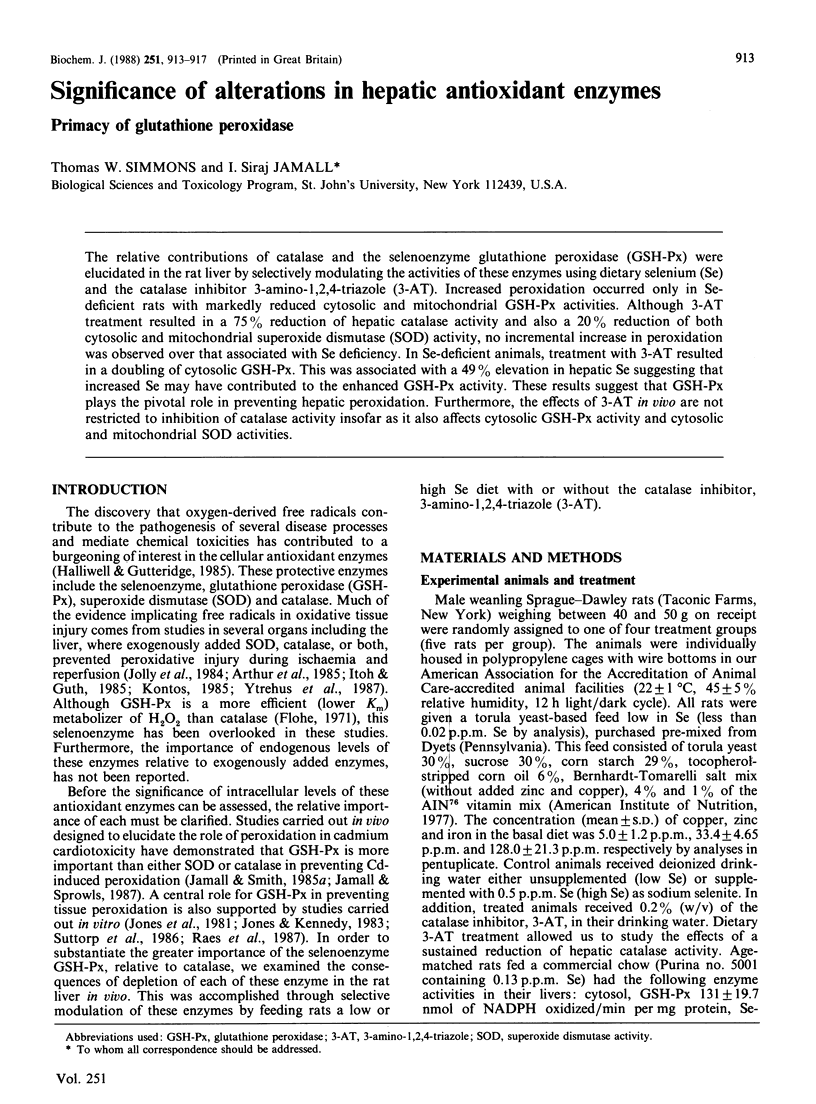
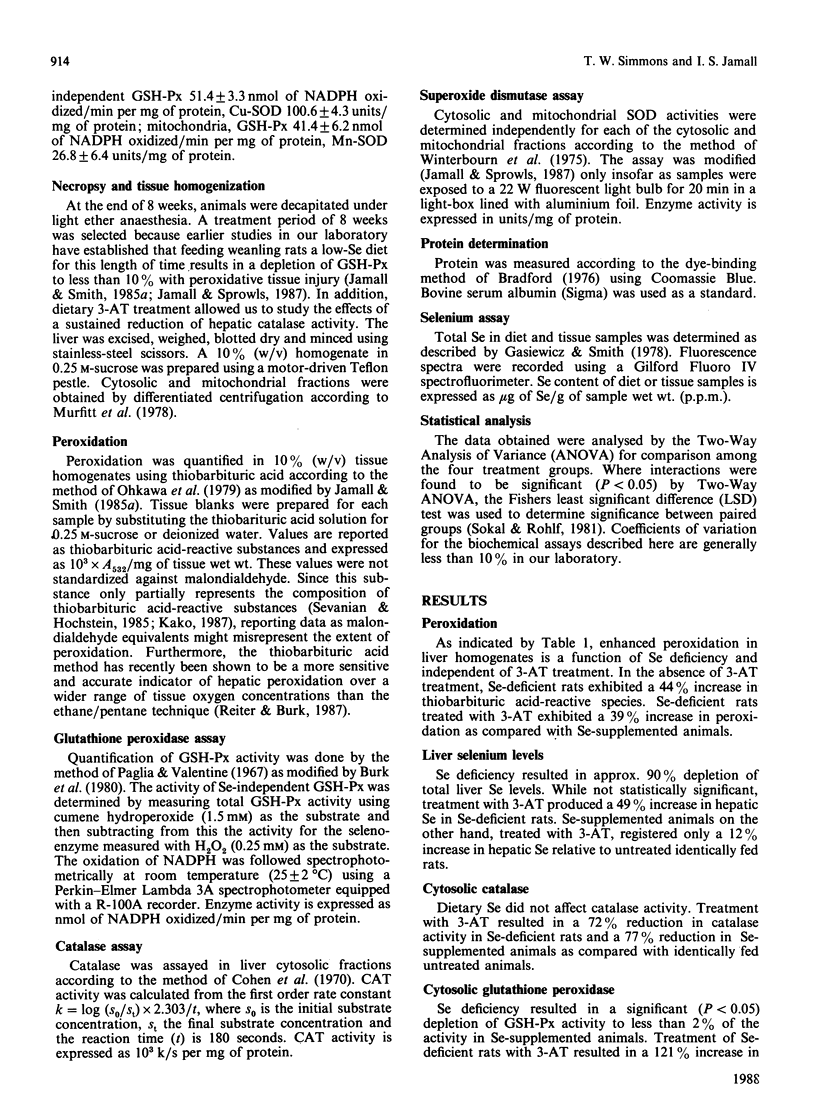
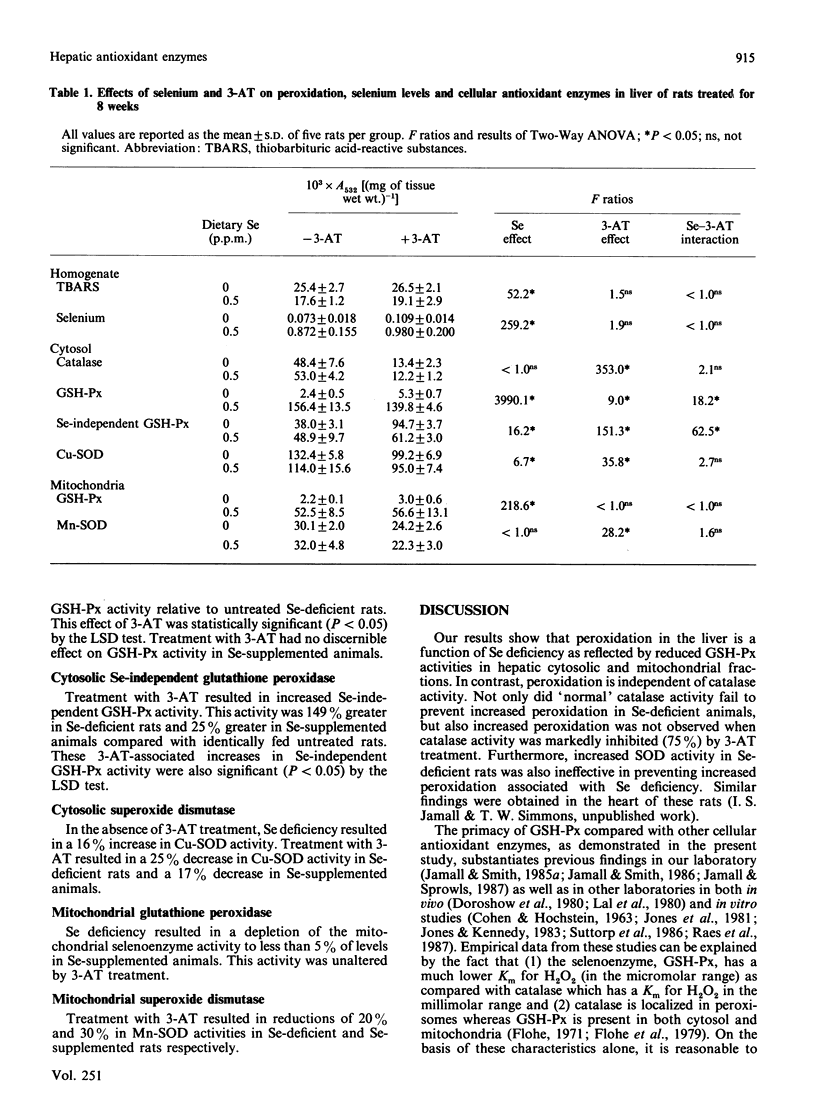
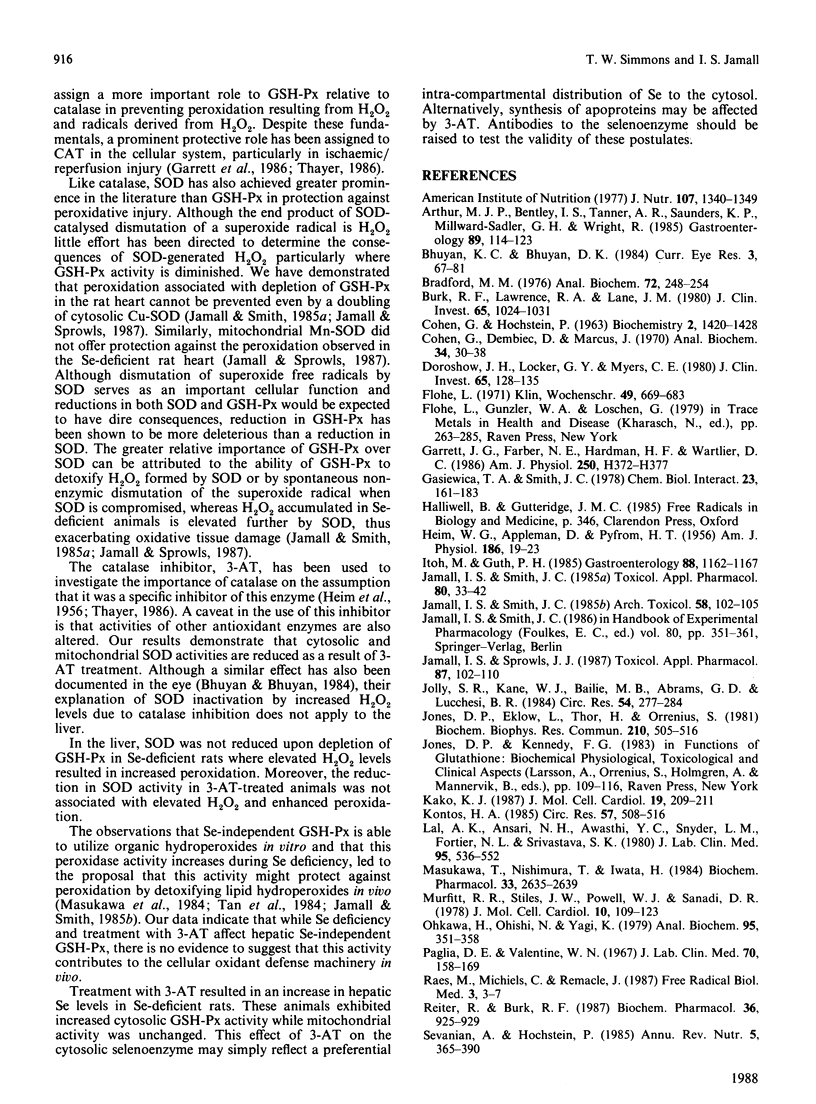
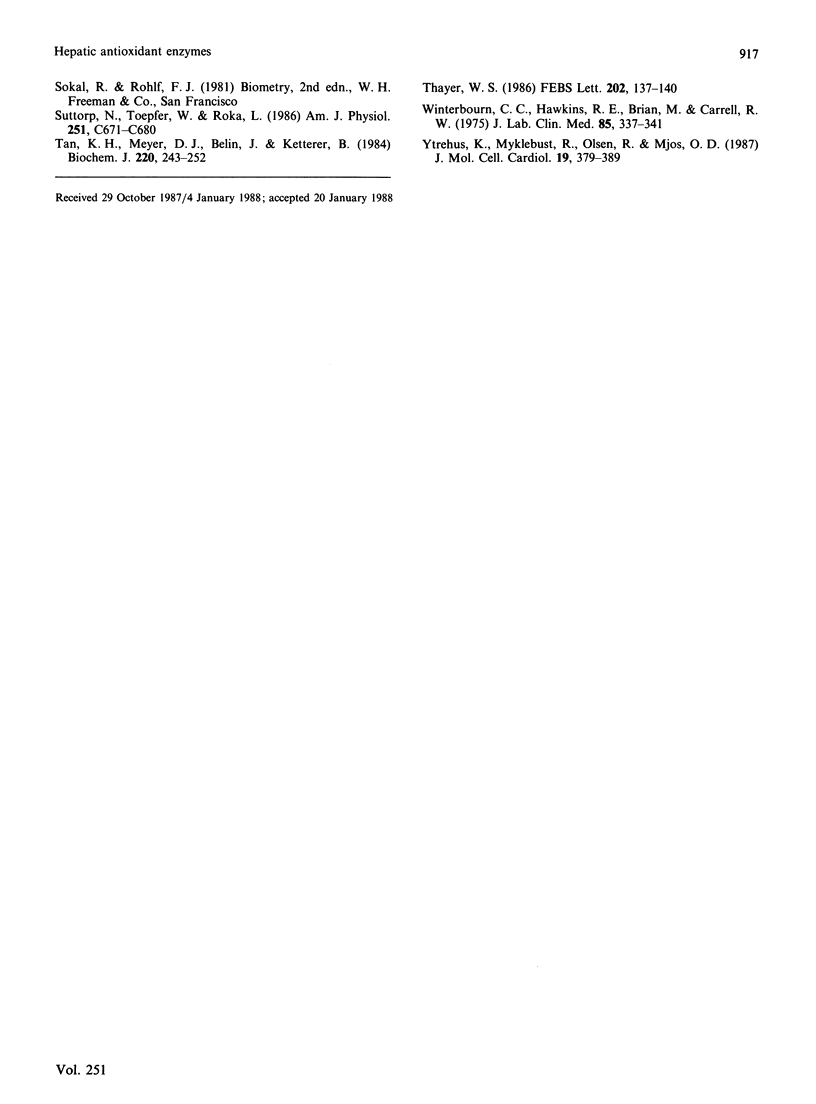
Selected References
These references are in PubMed. This may not be the complete list of references from this article.
- APPLEMAN D., HEIM W. G., PYFROM H. T. Effects of 3-amino-1, 2, 4-triazole (AT) on catalase and other compounds. Am J Physiol. 1956 Jul;186(1):19–23. doi: 10.1152/ajplegacy.1956.186.1.19. [DOI] [PubMed] [Google Scholar]
- Bhuyan K. C., Bhuyan D. K. Molecular mechanism of cataractogenesis: III. Toxic metabolites of oxygen as initiators of lipid peroxidation and cataract. Curr Eye Res. 1984 Jan;3(1):67–81. doi: 10.3109/02713688408997188. [DOI] [PubMed] [Google Scholar]
- Bradford M. M. A rapid and sensitive method for the quantitation of microgram quantities of protein utilizing the principle of protein-dye binding. Anal Biochem. 1976 May 7;72:248–254. doi: 10.1006/abio.1976.9999. [DOI] [PubMed] [Google Scholar]
- Burk R. F., Lawrence R. A., Lane J. M. Liver necrosis and lipid peroxidation in the rat as the result of paraquat and diquat administration. Effect of selenium deficiency. J Clin Invest. 1980 May;65(5):1024–1031. doi: 10.1172/JCI109754. [DOI] [PMC free article] [PubMed] [Google Scholar]
- COHEN G., HOCHSTEIN P. GLUTATHIONE PEROXIDASE: THE PRIMARY AGENT FOR THE ELIMINATION OF HYDROGEN PEROXIDE IN ERYTHROCYTES. Biochemistry. 1963 Nov-Dec;2:1420–1428. doi: 10.1021/bi00906a038. [DOI] [PubMed] [Google Scholar]
- Cohen G., Dembiec D., Marcus J. Measurement of catalase activity in tissue extracts. Anal Biochem. 1970 Mar;34:30–38. doi: 10.1016/0003-2697(70)90083-7. [DOI] [PubMed] [Google Scholar]
- Doroshow J. H., Locker G. Y., Myers C. E. Enzymatic defenses of the mouse heart against reactive oxygen metabolites: alterations produced by doxorubicin. J Clin Invest. 1980 Jan;65(1):128–135. doi: 10.1172/JCI109642. [DOI] [PMC free article] [PubMed] [Google Scholar]
- Flohé L. Die Glutathionperoxidase: Enzymologie und biologische Aspekte. Klin Wochenschr. 1971 Jun 15;49(12):669–683. doi: 10.1007/BF01487101. [DOI] [PubMed] [Google Scholar]
- Gross G. J., Farber N. E., Hardman H. F., Warltier D. C. Beneficial actions of superoxide dismutase and catalase in stunned myocardium of dogs. Am J Physiol. 1986 Mar;250(3 Pt 2):H372–H377. doi: 10.1152/ajpheart.1986.250.3.H372. [DOI] [PubMed] [Google Scholar]
- Itoh M., Guth P. H. Role of oxygen-derived free radicals in hemorrhagic shock-induced gastric lesions in the rat. Gastroenterology. 1985 May;88(5 Pt 1):1162–1167. doi: 10.1016/s0016-5085(85)80075-5. [DOI] [PubMed] [Google Scholar]
- Jamall I. S., Smith J. C. Effects of cadmium on glutathione peroxidase, superoxide dismutase, and lipid peroxidation in the rat heart: a possible mechanism of cadmium cardiotoxicity. Toxicol Appl Pharmacol. 1985 Aug;80(1):33–42. doi: 10.1016/0041-008x(85)90098-5. [DOI] [PubMed] [Google Scholar]
- Jamall I. S., Smith J. C. Effects of cadmium treatment on selenium-dependent and selenium-independent glutathione peroxidase activities and lipid peroxidation in the kidney and liver of rats maintained on various levels of dietary selenium. Arch Toxicol. 1985 Dec;58(2):102–105. doi: 10.1007/BF00348317. [DOI] [PubMed] [Google Scholar]
- Jamall I. S., Sprowls J. J. Effects of cadmium and dietary selenium on cytoplasmic and mitochondrial antioxidant defense systems in the heart of rats fed high dietary copper. Toxicol Appl Pharmacol. 1987 Jan;87(1):102–110. doi: 10.1016/0041-008x(87)90088-3. [DOI] [PubMed] [Google Scholar]
- Jolly S. R., Kane W. J., Bailie M. B., Abrams G. D., Lucchesi B. R. Canine myocardial reperfusion injury. Its reduction by the combined administration of superoxide dismutase and catalase. Circ Res. 1984 Mar;54(3):277–285. doi: 10.1161/01.res.54.3.277. [DOI] [PubMed] [Google Scholar]
- Jones D. P., Eklöw L., Thor H., Orrenius S. Metabolism of hydrogen peroxide in isolated hepatocytes: relative contributions of catalase and glutathione peroxidase in decomposition of endogenously generated H2O2. Arch Biochem Biophys. 1981 Sep;210(2):505–516. doi: 10.1016/0003-9861(81)90215-0. [DOI] [PubMed] [Google Scholar]
- Kako K. J. Free radical effects on membrane protein in myocardial ischemia/reperfusion injury. J Mol Cell Cardiol. 1987 Feb;19(2):209–211. doi: 10.1016/s0022-2828(87)80563-1. [DOI] [PubMed] [Google Scholar]
- Kontos H. A. George E. Brown memorial lecture. Oxygen radicals in cerebral vascular injury. Circ Res. 1985 Oct;57(4):508–516. doi: 10.1161/01.res.57.4.508. [DOI] [PubMed] [Google Scholar]
- Lal A. K., Ansari N. H., Awasthi Y. C., Snyder L. M., Fortier N. L., Srivastava S. K. Defense of mouse red blood cells against oxidative damage by phenylhydrazine. Glutathione peroxidase and catalase deficiency. J Lab Clin Med. 1980 Apr;95(4):536–552. [PubMed] [Google Scholar]
- Masukawa T., Nishimura T., Iwata H. Differential changes of glutathione S-transferase activity by dietary selenium. Biochem Pharmacol. 1984 Aug 15;33(16):2635–2639. doi: 10.1016/0006-2952(84)90637-3. [DOI] [PubMed] [Google Scholar]
- Murfitt R. R., Stiles J. W., Powell W. J., Jr, Sanadi D. R. Experimental myocardial ischemia characteristics of isolated mitochondrial subpopulations. J Mol Cell Cardiol. 1978 Feb;10(2):109–123. doi: 10.1016/0022-2828(78)90036-6. [DOI] [PubMed] [Google Scholar]
- Ohkawa H., Ohishi N., Yagi K. Assay for lipid peroxides in animal tissues by thiobarbituric acid reaction. Anal Biochem. 1979 Jun;95(2):351–358. doi: 10.1016/0003-2697(79)90738-3. [DOI] [PubMed] [Google Scholar]
- Paglia D. E., Valentine W. N. Studies on the quantitative and qualitative characterization of erythrocyte glutathione peroxidase. J Lab Clin Med. 1967 Jul;70(1):158–169. [PubMed] [Google Scholar]
- Raes M., Michiels C., Remacle J. Comparative study of the enzymatic defense systems against oxygen-derived free radicals: the key role of glutathione peroxidase. Free Radic Biol Med. 1987;3(1):3–7. doi: 10.1016/0891-5849(87)90032-3. [DOI] [PubMed] [Google Scholar]
- Reiter R., Burk R. F. Effect of oxygen tension on the generation of alkanes and malondialdehyde by peroxidizing rat liver microsomes. Biochem Pharmacol. 1987 Mar 15;36(6):925–929. doi: 10.1016/0006-2952(87)90186-9. [DOI] [PubMed] [Google Scholar]
- Sevanian A., Hochstein P. Mechanisms and consequences of lipid peroxidation in biological systems. Annu Rev Nutr. 1985;5:365–390. doi: 10.1146/annurev.nu.05.070185.002053. [DOI] [PubMed] [Google Scholar]
- Suttorp N., Toepfer W., Roka L. Antioxidant defense mechanisms of endothelial cells: glutathione redox cycle versus catalase. Am J Physiol. 1986 Nov;251(5 Pt 1):C671–C680. doi: 10.1152/ajpcell.1986.251.5.C671. [DOI] [PubMed] [Google Scholar]
- Tan K. H., Meyer D. J., Belin J., Ketterer B. Inhibition of microsomal lipid peroxidation by glutathione and glutathione transferases B and AA. Role of endogenous phospholipase A2. Biochem J. 1984 May 15;220(1):243–252. doi: 10.1042/bj2200243. [DOI] [PMC free article] [PubMed] [Google Scholar]
- Thayer W. S. Role of catalase in metabolism of hydrogen peroxide by the perfused rat heart. FEBS Lett. 1986 Jun 23;202(1):137–140. doi: 10.1016/0014-5793(86)80664-0. [DOI] [PubMed] [Google Scholar]
- Winterbourn C. C., Hawkins R. E., Brian M., Carrell R. W. The estimation of red cell superoxide dismutase activity. J Lab Clin Med. 1975 Feb;85(2):337–341. [PubMed] [Google Scholar]
- Ytrehus K., Myklebust R., Olsen R., Mjøs O. D. Ultrastructural changes induced in the isolated rat heart by enzymatically generated oxygen radicals. J Mol Cell Cardiol. 1987 Apr;19(4):379–389. doi: 10.1016/s0022-2828(87)80583-7. [DOI] [PubMed] [Google Scholar]


